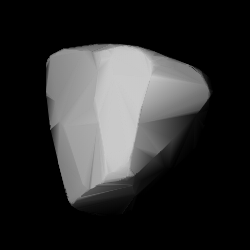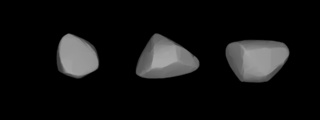Arago, provisional designation 1923 OT, is a dark asteroid from the outer regions of the asteroid belt, approximately 55 kilometers in diameter. It was discovered on 5 September 1923, by Russian astronomer Sergey Belyavsky at the Simeiz Observatory on the Crimean peninsula. The asteroid was named after French mathematician François Arago.
Pawlowia, provisional designation 1923 OX, is a background asteroid from the central regions of the asteroid belt, approximately 20 kilometers in diameter. It was discovered on 5 October 1923, by Soviet astronomer Vladimir Albitsky at the Simeiz Observatory on the Crimean peninsula. The asteroid was named after Russian physiologist and Nobelist Ivan Pavlov.
1031 Arctica, provisional designation 1924 RR, is a dark asteroid from the outer region of the asteroid belt, approximately 75 kilometers in diameter. It was discovered on 6 June 1924, by Soviet−Russian astronomer Sergey Belyavsky at Simeiz Observatory on the Crimean peninsula. It was named for the Arctic Sea.
1074 Beljawskya, provisional designation 1925 BE, is a Themistian asteroid from the outer region of the asteroid belt, approximately 48 kilometers in diameter.

1135 Colchis ; prov. designation: 1929 TA) is a background asteroid from the central region of the asteroid belt. It was discovered on 3 October 1929, by Soviet astronomer Grigory Neujmin at the Simeiz Observatory on the Crimean peninsula. The X-type asteroid has a rotation period of hours 23.5 and measures approximately 49 kilometers in diameter. It was named for the ancient Kingdom of Colchis.
1120 Cannonia, provisional designation 1928 RV, is a stony Florian asteroid from the inner regions of the asteroid belt, approximately 10 kilometers in diameter. Discovered by Pelageya Shajn at Simeiz in 1928, it was named after American astronomer Annie Jump Cannon.
1123 Shapleya, provisional designation 1928 ST, is a stony Florian asteroid from the inner regions of the asteroid belt, approximately 11 kilometers in diameter. It was discovered on 21 September 1928, by Russian astronomer Grigory Neujmin at Simeiz Observatory on the Crimean peninsula. It was named after American astronomer Harlow Shapley.

1129 Neujmina is an Eos asteroid from the outer regions of the asteroid belt. It was discovered on 8 August 1929, by astronomer Praskoviya Parchomenko at the Simeiz Observatory on the Crimean peninsula. The stony S-type asteroid has a rotation period of 5.1 hours and measures approximately 34 kilometers in diameter. It was named after Soviet astronomer Grigory Neujmin.
1151 Ithaka, provisional designation 1929 RK, is a carbonaceous asteroid from the inner regions of the asteroid belt, approximately 14 kilometers in diameter. It was discovered by Karl Reinmuth at the Heidelberg-Königstuhl State Observatory in 1929, and later named for the Greek island of Ithaca.

1848 Delvaux is a stony Koronis asteroid from the outer region of the asteroid belt, approximately 17 kilometers in diameter. It was discovered on 18 August 1933, by Belgian astronomer Eugène Delporte at the Royal Observatory of Belgium in Uccle, Belgium. It was later named after astronomer Georges Roland's sister-in-law.
1309 Hyperborea is a carbonaceous background asteroid from the outermost regions of the asteroid belt, approximately 57 kilometers in diameter. It was discovered on 11 October 1931, by Soviet astronomer Grigory Neujmin at the Simeiz Observatory on the Crimean peninsula, and given the provisional designation 1931 TO. The asteroid was named after Hyperborea, the northern homeland of a Greek mythical race of giants.
1271 Isergina, provisional designation 1931 TN, is a carbonaceous background asteroid from the outer regions of the asteroid belt, approximately 45 kilometers in diameter. It was discovered on 10 October 1931, by Soviet astronomer Grigory Neujmin at the Simeiz Observatory on the Crimean peninsula. The asteroid was named after Crimean physician and friend of the discoverer, Pyotr Isergin.
1469 Linzia, provisional designation 1938 QD, is a dark asteroid from the outer regions of the asteroid belt, approximately 60 kilometers in diameter. Discovered by Karl Reinmuth at Heidelberg Observatory in 1938, the asteroid was later named after the Austrian city of Linz.
1303 Luthera, provisional designation 1928 FP, is a dark asteroid and the parent body of the Luthera family, located in the outermost regions of the asteroid belt. It measures approximately 90 kilometers in diameter. The asteroid was discovered on 16 March 1928, by astronomer Friedrich Schwassmann at the Bergedorf Observatory in Hamburg, Germany, and later named after German astronomer Robert Luther.
1347 Patria, provisional designation 1931 VW, is a carbonaceous asteroid from the background population of the central asteroid belt, approximately 32 kilometers in diameter. It was discovered on 6 November 1931, by Soviet astronomer Grigory Neujmin at the Simeiz Observatory on the Crimean peninsula. The asteroid was named for the Latin word of fatherland.

1518 Rovaniemi, provisional designation 1938 UA, is a stony Florian asteroid from the inner regions of the asteroid belt, approximately 8 kilometers in diameter. Discovered by Yrjö Väisälä at the Turku Observatory in 1938, the asteroid was later named after the Finnish city of Rovaniemi.
1306 Scythia, provisional designation 1930 OB, is a dark Ursula asteroid from the outer regions of the asteroid belt, approximately 72 kilometers in diameter. It was discovered on 22 July 1930, by Soviet astronomer Grigory Neujmin at the Simeiz Observatory on the Crimean peninsula. The asteroid was named for the historic region of Scythia.

1648 Shajna, provisional designation 1935 RF, is a stony asteroid from the inner regions of the asteroid belt, approximately 9 kilometers in diameter. It was discovered on 5 September 1935, by Russian astronomer Pelageya Shajn at Simeiz Observatory on the Crimean peninsula. Two weeks later, it was independently discovered by Cyril Jackson at Johannesburg Observatory, South Africa. It was later named after the discoverer and her husband, Russian astronomers Grigory Shajn.
1692 Subbotina, provisional designation 1936 QD, is a dark background asteroid from the central region of the asteroid belt, approximately 37 kilometers in diameter. The carbonaceous Cg-type asteroid has a rotation period of 9.2 hours. It was discovered by Grigory Neujmin at the Crimean Simeiz Observatory in 1936, and later named after Soviet mathematician and astronomer Mikhail Subbotin.

1189 Terentia, provisional designation 1930 SG, is a carbonaceous Terentian asteroid from the outer regions of the asteroid belt, approximately 56 kilometers in diameter and the namesake of its family. The asteroid was discovered by Russian astronomer Grigory Neujmin at Simeiz Observatory on 17 September 1930.






